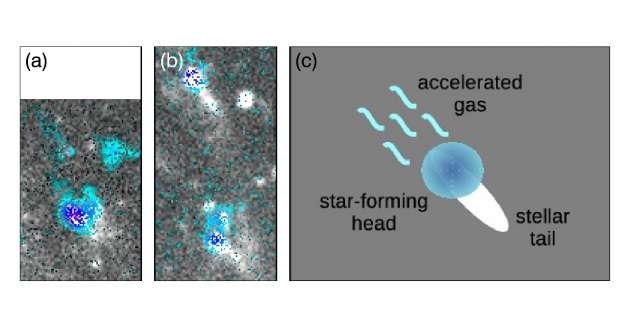April 24, 2017 report
Jellyfish-shaped galaxy found in Abell 2670 cluster

(Phys.org)—Using the Multi Unit Spectroscopic Explorer (MUSE), astronomers have identified a new elliptical jellyfish-like galaxy in the Abell 2670 cluster. The newly detected galaxy showcases spectacular one-sided tails of gas and young stars, which indicates intense ram-pressure stripping. The findings were presented Apr. 18 in a paper published on the arXiv pre-print server.
The so-called "jellyfish" galaxies are extreme examples of stripped galaxies exhibiting tentacles of debris material with a characteristic jellyfish-like morphology. When a galaxy infalls into a massive cluster halo, it experiences ram pressure as it moves through the intracluster medium. The ram pressure is responsible for gas stripping processes and for creating star-forming tails and blobs.
Although elliptical galaxies experience ram pressure when they move through intracluster medium, they are unlikely to be significantly affected by such force due to their gas-poor nature and low levels of star formation. Notably, jellyfish-like features have not been reported in elliptical galaxies yet, so the new discovery is invaluable for researchers studying the morphology of such galaxies.
In the recently published paper, a team of astronomers led by Yun-Kyeong Sheen of the Korea Astronomy and Space Science Institute in Daejeon, South Korea, presents the results of observation of Abell 2670 cluster using the MUSE instrument mounted on ESO's Very Large Telescope (VLT) in Chile. The deep optical images obtained by MUSE allowed the researchers to discover a new elliptical galaxy showing disturbed halo features and surrounded by several blue blobs.
"In this paper, we present MUSE observations of an elliptical galaxy in Abell 2670 with long tails of material visible in the optical spectra, as well as blobs with tadpole-like morphology," the authors wrote in the paper.
In particular, the team found an extended H-alpha disk at the galaxy center, with bright concentrated emission at the centre, and long ionized gas tails emanating from the disk. They also detected several blue star forming blobs, with a tadpole-like morphology, surrounding the galaxy. Moreover, they found H-alpha blobs located at the positions corresponding to the blue blobs found in deep optical images.
The researchers noted that the observed gas tails point away from the cluster center, which could be an indicator of a ram-pressure stripping currently taking place. Furthermore, the tails of star forming blobs point upstream, towards the cluster center, which also supports this assumption.
The authors concluded that the newly found galaxy is a post-merger elliptical galaxy currently undergoing ram pressure stripping. They assume that the gas and the star-forming blobs were most likely acquired during a past wet merger.
"Where does the gas come from? A likely scenario is that a wet merger occurred. Many merger features are apparent, as indicated by disturbed halo features and stellar streams in our deep optical imaging. (…) Another possibility is that these star-forming blobs are, in fact, tidal dwarf galaxies (TDGs) formed during the wet merger. This could explain their large masses, and lack of a spatial correlation with the ionized gas stream," the paper reads.
More information: Discovery of ram pressure stripped gas around an elliptical galaxy in Abell 2670, arxiv.org/abs/1704.05173
Abstract
Studies of cluster galaxies are increasingly finding galaxies with spectacular one-sided tails of gas and young stars, suggestive of intense ram-pressure stripping. These so-called "jellyfish" galaxies typically have late-type morphology. In this paper, we present MUSE observations of an elliptical galaxy in Abell 2670 with long tails of material visible in the optical spectra, as well as blobs with tadpole-like morphology. The spectra in the central part of the galaxy reveals a stellar component as well as ionized gas. The stellar component does not have significant rotation, while the ionized gas defines a clear star-forming gas disk. We argue, based on deep optical images of the galaxy, that the gas was most likely acquired during a past wet merger. It is possible that the star-forming blobs are also remnants of the merger. In addition, the direction and kinematics of the one-sided ionized tails, combined with the tadpole morphology of the star-forming blobs, strongly suggests that the system is undergoing ram pressure from the intracluster medium. In summary, this paper presents the discovery of a post-merger elliptical galaxy undergoing ram pressure stripping.
© 2017 Phys.org





















